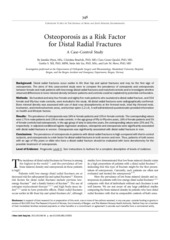Osteoporosis as a Risk Factor for Distal Radial Fractures. A Case-Control Study
Øyen, Jannike; Brudvik, Christina; Gjesdal, Clara Gram; Tell, Grethe Seppola; Lie, Stein Atle; Hove, Leiv M.
Peer reviewed, Journal article
Published version
Permanent lenke
https://hdl.handle.net/1956/4765Utgivelsesdato
2011Metadata
Vis full innførselSamlinger
Originalversjon
https://doi.org/10.2106/jbjs.j.00303Sammendrag
Background: Distal radial fractures occur earlier in life than hip and spinal fractures and may be the first sign of osteoporosis. The aims of this case-control study were to compare the prevalence of osteopenia and osteoporosis between female and male patients with low-energy distal radial fractures and matched controls and to investigate whether observed differences in bone mineral density between patients and controls could be explained by potential confounders. Methods: Six hundred and sixty-four female and eighty-five male patients who sustained a distal radial fracture, and 554 female and fifty-four male controls, were included in the study. All distal radial fractures were radiographically confirmed. Bone mineral density was assessed with use of dual x-ray absorptiometry at the femoral neck, total hip (femoral neck, trochanter, and intertrochanteric area), and lumbar spine (L2-L4). A self-administered questionnaire provided information on health and lifestyle factors. Results: The prevalence of osteoporosis was 34% in female patients and 10% in female controls. The corresponding values were 17% in male patients and 13% in male controls. In the age group of fifty to fifty-nine years, 18% of female patients and 5% of female controls had osteoporosis. In the age group of sixty to sixty-nine years, the corresponding values were 25% and 7%, respectively. In adjusted conditional logistic regression analyses, osteopenia and osteoporosis were significantly associated with distal radial fractures in women. Osteoporosis was significantly associated with distal radial fractures in men. Conclusions: The prevalence of osteoporosis in patients with distal radial fractures is high compared with that in control subjects, and osteoporosis is a risk factor for distal radial fractures in both women and men. Thus, patients of both sexes with an age of fifty years or older who have a distal radial fracture should be evaluated with bone densitometry for the possible treatment of osteoporosis.
Utgiver
The Journal of Bone and Joint Surgery, Inc.Opphavsrett
The Journal of Bone and Joint Surgery, Inc.Copyright 2011 The Journal of Bone and Joint Surgery, Inc.
